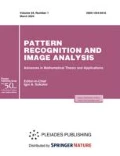Abstract
This paper addresses some current problems associated with the development of computer graphics technologies. We propose a possible solution based on the use of object shaders for the further evolution of the graphics pipeline technology. The visualization problem is formalized to generate a set of procedures (object shaders) that implement a programmable pipeline.


Similar content being viewed by others
REFERENCES
S. A. Cholewiak, G. D. Love, P. P. Srinivasan, et al., “ChromaBlur: Renderering chromatic eye aberration improves accommodation and realism”, ACM Trans. Graphics (TOG) 36 (6), Article 210, 210:1–210:12 (2017).
K. Park, K. Rematas, A. Farhadi, and S. M. Seitz, “PhotoShape: Photorealistic materials for large-scale shape collections”, ACM Trans. Graphics (TOG) 37 (6), Article 192, 192:1–192:12 (2018).
S. Suwajanakorn, S. M. Seitz, and I. Kemelmacher-Shlizerman, “Synthesizing Obama: Learning lip sync from audio”, ACM Trans. Graphics (TOG) 36 (4), Article 95, 95:1–95:13 (2017).
Y. He, T. Foley, T. Hofstee, et al., “Shader components: Modular and high performance shader development”, ACM Trans. Graphics (TOG) 36 (4), Article 100, 100:1–110:11 (2017).
Why video games are so expensive to develop, The Economist (September 25, 2014). https://www.economist.com/the-economist-explains/2014/09/24/why-video-games-are-so-expensive-to-develop
G. Shakah, M. Alkhasawneh, V. Krasnoproshin, and D. Mazouka, “Graphics pipeline evolution: problems and solutions”, J. Comput. Sci. 15 (7), 880–885 (2019). https://doi.org/10.3844/jcssp.2019.880.885
Epic Games, Unreal Engine. https://www.unrealengine.com/en-US/what-is-unreal-engine-4
Microsoft Direct3D 12 Graphics Programming Guide. Important Changes from Direct3D 11 to Direct3D 12 https://docs.microsoft.com/en-us/windows/desktop/direct3d12/important-changes-from-directx-11-to-directx-12
Khronos Group, Vulkan. https://www.khronos.org/vulkan/
M. Kenzel, B. Kerbl, D. Schmalstieg, and M. Steinberger, “A high-performance software graphics pipeline architecture for the GPU”, ACM Trans. Graphics (TOG) 37 (4), Article 140, 140:1–140:15 (2018).
V. Krasnoproshin and D. Mazouka. “Novel approach to dynamic models visualization”, J. Comput. Optim. Econ. Finance 4 (2–3), 113–124 (2013).
V. Krasnoproshin and D. Mazouka, “Data-driven method for high level rendering pipeline construction”, in Neural Networks and Artificial Intelligence, ICNNAI 2014, Ed. by V. Golovko and A. Imada, Communications in Computer and Information Science (Springer, Cham, 2014), Vol. 440, pp 191–200.
V. Krasnoproshin and D. Mazouka, “Frame manipulation techniques in object-based rendering”, in Pattern Recognition and Information Processing, PRIP 2016, Ed. by V. Krasnoproshin and S. Ablameyko, Communications in Computer and Information Science (Springer, Cham, 2017), Vol. 673, pp. 97–105.
D. Mazouka and V. Krasnoproshin, “Integration of graphics engines into graphics pipeline technology”, Proc. 14th Int. Conf. Pattern Recognition and Information Processing (PRIP’2019) (Bestprint, Minsk, 2019), pp. 186–190.
G. Booch, “Object-oriented development”, IEEE Trans. Software Eng. SE-12 (2), 211–221 (1986).
L. A. Zadeh, “The concept of a linguistic variable and its application to approximate reasoning – I”, Inf. Sci. 8 (3), 199–249 (1975).
N. Llopis, “High-performance programming with data-oriented design”, in Game Engine Gems 2. Ed. by E. Lengyel (A. K. Peters/CRC Press, Boca Raton, 2011), pp. 251–261.
Author information
Authors and Affiliations
Corresponding authors
Ethics declarations
The authors declare that they have no conflict of interest.
Additional information

V. V. Krasnoproshin was born in 1947, graduated from the Belarusian State University in 1974, received a candidate’s degree in 1979 and doctoral degree in 2007. Currently, he is a full professor at the Belarusian State University and Head of the Information Management Systems Department, Faculty of Applied Mathematics and Computer Sciences. His research interests include artificial intelligence, pattern recognition, image analyses, computer graphics, information and computing technologies. He is the author of more than 300 papers, including 9 books.

D. I. Mazouka was born in 1986, graduated from the Belarusian State University in 2008, and received a master’s degree in 2010. Currently, he is a PhD student at the Belarusian State University, Department of Information Management Systems, Faculty of Applied Mathematics and Computer Sciences. His research interests include computer graphics and visualization systems. He is the author of 21 papers.
Translated by Yu. Kornienko
Rights and permissions
About this article
Cite this article
Krasnoproshin, V., Mazouka, D. Graphics Pipeline Evolution Based on Object Shaders. Pattern Recognit. Image Anal. 30, 192–202 (2020). https://doi.org/10.1134/S105466182002008X
Received:
Revised:
Accepted:
Published:
Issue Date:
DOI: https://doi.org/10.1134/S105466182002008X




